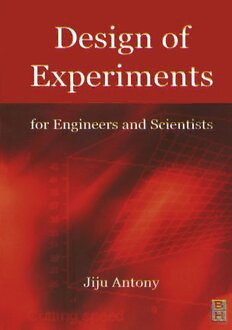Table Of Content//SYS21///INTEGRAS/ELS/ELSEVIERUK/DEEM/REVISES_16-06-03/0750647094-CH000-PRELIMS.3D–1–[1–
12/12]9.7.20036:28PM
Design of Experiments for Engineers and Scientists
This Page is Intentionally Left Blank
//SYS21///INTEGRAS/ELS/ELSEVIERUK/DEEM/REVISES_16-06-03/0750647094-CH000-PRELIMS.3D–3–[1–
12/12]9.7.20036:28PM
Design of Experiments for Engineers
and Scientists
Jiju Antony
AMSTERDAM BOSTON HEIDELBERG LONDON NEWYORK OXFORD
PARIS SANDIEGO SANFRANCISCO SINGAPORE SYDNEY TOKYO
//SYS21///INTEGRAS/ELS/ELSEVIERUK/DEEM/REVISES_16-06-03/0750647094-CH000-PRELIMS.3D–4–[1–
12/12]9.7.20036:28PM
Butterworth-Heinemann
AnimprintofElsevier
LinacreHouse,JordanHill,OxfordOX28DP
200WheelerRoad,Burlington,MA01803
Firstpublished2003
Copyright(cid:1)2003,JijuAntony.Allrightsreserved
TherightofJijuAntonytobeidentifiedastheauthorofthiswork
hasbeenassertedinaccordancewiththeCopyright,Designsand
PatentsAct1988
Nopartofthispublicationmaybereproducedinanymaterialform(including
photocopyingorstoringinanymediumbyelectronicmeansandwhether
ornottransientlyorincidentallytosomeotheruseofthispublication)without
thewrittenpermissionofthecopyrightholderexceptinaccordancewiththe
provisionsoftheCopyright,DesignsandPatentsAct1988orunderthetermsof
alicenceissuedbytheCopyrightLicensingAgencyLtd,90TottenhamCourtRoad,
London,EnglandW1T4LP.Applicationsforthecopyrightholder’swritten
permissiontoreproduceanypartofthispublicationshouldbeaddressed
tothepublisher
PermissionsmaybesoughtdirectlyfromElsevier’sScienceand
TechnologyRightsDepartmentinOxford,UK.Phone:(þ44)(0)1865843830;
fax:(þ44)(0)1865853333;e-mail:[email protected]
completeyourrequeston-lineviatheElsevierhomepage
(http://www.elsevier.com),byselecting‘CustomerSupport’andthen‘Obtaining
Permissions’
BritishLibraryCataloguinginPublicationData
AcataloguerecordforthisbookisavailablefromtheBritishLibrary
LibraryofCongressCataloguinginPublicationData
AcataloguerecordforthisbookisavailablefromtheLibraryofCongress
ISBN0750647094
ForinformationonallButterworth-Heinemannpublications
visitourwebsiteatwww.bh.com
TypesetbyIntegraSoftwareServicesPvt.Ltd,Pondicherry,India
www.integra-india.com
PrintedandboundinGreatBritain
//SYS21///INTEGRAS/ELS/ELSEVIERUK/DEEM/REVISES_16-06-03/0750647094-CH000-PRELIMS.3D–5–[1–
12/12]9.7.20036:28PM
This book is dedicated to my late papa who instilled in me the importance
ofeducation
This Page is Intentionally Left Blank
//SYS21///INTEGRAS/ELS/ELSEVIERUK/DEEM/REVISES_16-06-03/0750647094-CH000-PRELIMS.3D–7–[1–
12/12]9.7.20036:28PM
Contents
Preface xi
Acknowledgements xii
1 Introduction toindustrial experimentation 1
1.1 Introduction 1
1.2 Some fundamental and practical issues in
industrialexperimentation 3
1.3 Summary 5
Exercises 5
References 5
2 Fundamentals of Design of Experiments 6
2.1 Introduction 6
2.2 Basic principles ofDesign ofExperiments 7
2.2.1 Randomization 8
2.2.2 Replication 9
2.2.3 Blocking 10
2.3 Degreesof freedom 10
2.4 Confounding 11
2.5 Design resolution 12
2.6 Metrology considerations for industrialdesigned
experiments 12
2.6.1 Measurement system capability 13
2.6.2 Some tipsfor the development ofa
measurement system 14
2.7 Selection ofquality characteristics for industrial
experiments 15
Exercises 15
References 16
3 Understanding key interactions inprocesses 17
3.1 Introduction 17
3.2 Alternative method for calculating the two
order interactioneffect 20
3.3 Synergistic interactionvs antagonistic interaction 22
3.4 Scenario 1 23
//SYS21///INTEGRAS/ELS/ELSEVIERUK/DEEM/REVISES_16-06-03/0750647094-CH000-PRELIMS.3D–8–[1–
12/12]9.7.20036:28PM
viii Contents
3.5 Scenario 2 25
3.6 Summary 27
Exercises 27
References 28
4 Asystematic methodology for Design ofExperiments 29
4.1 Introduction 29
4.2 Barriersinthe successful application of DOE 29
4.3 Apractical methodology for DOE 31
4.3.1 Planningphase 31
4.3.2 Designingphase 33
4.3.3 Conducting phase 33
4.3.4 Analysingphase 34
4.4 Analytical tools ofDOE 34
4.4.1 Main effectsplot 34
4.4.2 Interactions plots 35
4.4.3 Cubeplots 36
4.4.4 Pareto plot offactor effects 36
4.4.5 NormalProbability Plot offactor effects 36
4.4.6 NormalProbability Plot ofresiduals 37
4.4.7 Response surface plots and regressionmodels 38
4.5 Model buildingfor predictingresponse function 40
4.6 Confidence interval for the mean response 41
4.7 Summary 42
Exercises 42
References 43
5 Screeningdesigns 44
5.1 Introduction 44
5.2 Geometric and non-geometric P–B designs 44
5.3 Summary 52
Exercises 53
References 53
6 Full factorialdesigns 54
6.1 Introduction 54
6.2 Example ofa 22fullfactorialdesign 54
6.2.1 Objective 1:Determinationof main/interaction
effectswhich influence mean platingthickness 55
6.2.2 Objective 2:Determinationof main/interaction
effectswhich influence variability inplatingthickness 57
6.2.3 Objective 4:How toachieve atarget plating
thicknessof 120 units? 58
6.3 Example ofa 23fullfactorialdesign 60
6.3.1 Objective 1:To identify the significant main/
interactioneffectswhich affect the processyield 61
//SYS21///INTEGRAS/ELS/ELSEVIERUK/DEEM/REVISES_16-06-03/0750647094-CH000-PRELIMS.3D–9–[1–
12/12]9.7.20036:28PM
Contents ix
6.3.2 Objective 2:To identify the significant main/
interactioneffectswhichaffect the variabilityin
processyield 63
6.3.3 Objective 3:What isthe optimal process
condition? 64
6.4 Example ofa 24fullfactorialdesign 65
6.4.1 Objective 1:Which ofthe main/interaction
effectsaffect meancrack length? 66
6.4.2 Objective 2:Which ofthe main/interaction
effectsaffect variability in crack length? 66
6.4.3 Objective 3:What isthe optimal process condition to
minimizemeancracklength? 69
6.5 Summary 70
Exercises 71
References 72
7 Fractional factorialdesigns 73
7.1 Introduction 73
7.2 Constructionof half-fractional factorial designs 73
7.3 Example ofa 2(7(cid:1)4) factorialdesign 76
7.4 Anapplication of2-level fractional factorial design 80
7.5 Example ofa 2(5–1)factorial design 85
7.5.1 Objective 1:To identify the factorswhich
influence the meanfreeheight 86
7.5.2 Objective 2:To identify the factorswhich affect
variability inthe freeheightofleafsprings 87
7.5.3 How do we select the optimal factor settingsto
minimizevariability infreeheight? 89
7.6 Summary 90
Exercises 90
References 92
8 Some useful andpractical tips for making yourindustrial
experiments successful 93
8.1 Introduction 93
8.1.1 Get aclearunderstanding of the problem 94
8.1.2 Project selection 94
8.1.3 Conduct exhaustiveand detailed brainstorming
session 95
8.1.4 Teamwork andselection of ateam for
experimentation 96
8.1.5 Select the continuous measurablequality
characteristicsor responses for the experiment 96
8.1.6 Choice ofan appropriateExperimental Design 98
8.1.7 Iterativeexperimentation 98
8.1.8 Randomize the experimental trial order 99

